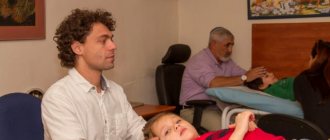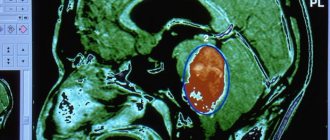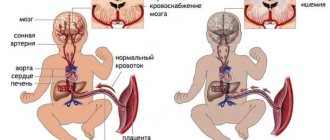Lennox-Gastaut syndrome is a type of epilepsy. This is a serious disease, which, in addition to the occurrence of seizures and atypical absence seizures, is characterized by impaired mental development in the child. The first manifestation of this disease is most often observed in children 1-5 years old, and boys are at risk. The development of the disease occurs against the background of neurological diseases that the baby suffered at an early age. The first signs of developing Lennox-Gastaut syndrome are considered to be sudden falls of the child. Next, epileptic signs and convulsions appear, and a slowdown in mental development becomes noticeable.
What is Lennox-Gastaut syndrome?
– Gastaut syndrome (LGS) is a severe form of epilepsy that usually appears in infancy or early childhood. Affected children experience several different types of seizures, most commonly atonic, tonic, and atypical seizures. Children with Lennox-Gastaut syndrome may also develop cognitive dysfunction, delays in achieving developmental milestones, and behavioral problems. LGS can be caused by a variety of underlying conditions, but in some cases the cause cannot be identified. LGS is difficult to treat because it is resistant (unresponsive) to many types of antiepileptic drugs. Research is ongoing to identify and evaluate new treatments for Lennox-Gastaut syndrome.
There is no consensus in the medical literature regarding the exact definition of Lennox-Gastaut syndrome. Typically, three findings are needed to make a diagnosis: multiple generalized types of seizures; slow burst-wave pattern (less than 2.5 Hz) on EEG; and cognitive dysfunction. A task force of the International League Against Epilepsy (ILEA) most recently classified the disorder as epileptic encephalopathy. Epileptic encephalopathies are a group of disorders in which seizure activity leads to progressive cognitive dysfunction.
Signs and symptoms
Symptoms of Lennox-Gastaut syndrome usually begin in infancy or childhood, most often between 3 and 5 years of age. Children with LGS are affected by several types of seizures, which are basically electrical disturbances in the brain. Most patients experience several types of seizures, several times during the day. As patients get older, the types and frequency of attacks may change.
The most common types of seizures associated with Lennox-Gastaut syndrome are tonic and atonic seizures. Tonic seizures cause increased muscle tone and muscle stiffness. They are characterized by sustained muscle contractions that can cause mild disturbances, such as slight bending of the body and momentary interruptions in breathing, or more serious problems, such as muscle spasms of the face and flexion or extension of the arms and legs. Affected children may extend their arms above their heads like a ballerina. Tonic seizures are usually short-lived (lasting a few seconds to a minute) and are especially common at night during sleep, but can also occur during the day. During a tonic seizure, a brief loss of consciousness usually occurs. Tonic seizures that occur upon awakening can cause patients to fall out of bed.
Atonic seizures cause a sudden loss of muscle tone and lethargy. They can lead to head nodding, posture problems, or sudden falls. Atonic seizures are also known as falling seizures. Atonic seizures can lead to head and facial injuries due to sudden, unexpected falls. While sitting, affected people may fall forward or backward at the waist. Atonic seizures may only partially affect consciousness and usually last only a few seconds
The third type of seizure commonly associated with Lennox-Gastaut syndrome is atypical absence seizures . This type of seizure is associated with a period of unconsciousness, usually marked by a blank stare. Absence seizures begin and end suddenly, and the affected person usually resumes activities with no memory of the episode. Absence seizures do not cause seizures and may be so mild that they go unnoticed. They usually last from a couple to several seconds. If a child is developmentally delayed, parents may notice only subtle changes in functioning or responsiveness.
Additional types of seizures may be less likely to affect people with Lennox-Gastaut syndrome. These include myoclonic seizures, which are characterized by abnormal jerking movements and may occur alone or in combination with atypical absence seizures; tonic-clonic seizures, which last a couple of minutes and are characterized by stiffness of the limbs, followed by twitching of the limbs and face; and partial or focal seizures, which involve electrical disturbances in a limited area of the brain and come in a variety of forms. Some people with Lennox-Gastaut syndrome experience prolonged continuous seizure activity that lasts more than 30 minutes (nonconvulsive status epilepticus). Nonconvulsive status epilepticus may go undetected. BES is the most difficult diagnostic task for a neurologist, epileptologist or neuroreanimatologist.
Children with Lennox-Gastaut syndrome usually, but not always, have impaired intelligence. Affected children may experience varying degrees of cognitive dysfunction and delays in achieving developmental milestones such as sitting, crawling or walking. Children with LGS may develop normally before the onset of seizures and then lose previously acquired skills (psychomotor regression). Because seizures associated with Lennox-Gastaut syndrome are usually resistant to treatment, intellectual impairment and learning problems may worsen over time. Children with LGS may also develop behavioral problems ranging from hyperactivity and irritability to autistic symptoms and psychosis.
In some cases, patients with Lennox-Gastaut syndrome may have initially suffered from infantile spasms. Infantile spasms, also known as West syndrome, are characterized by sudden, involuntary contractions of the head, neck and torso and/or uncontrolled extension of the legs and/or arms.
Nutritional Features
Very often, along with other therapeutic methods, the ketogenic diet is used. It represents a decrease in carbohydrate intake and an increase in fat intake.
In addition, foods with a low glycemic index are recommended, i.e. those that lower blood sugar levels. These include: fruits, vegetables, legumes, whole grains, skim milk.
During such a diet, the doctor should monitor the possibility of reducing the doses of medications taken.
Causes and risk factors
Approximately 70 to 80 percent of patients with Lennox-Gastaut syndrome have an identifiable cause. These cases can be called symptomatic Lennox-Gastaut syndrome. Examples of conditions that can cause Lennox-Gastaut syndrome include:
- abnormal development of the cerebral cortex (cortical dysplasia);
- congenital infections;
- stroke;
- head injuries;
- decreased oxygen supply that occurs before birth (perinatal hypoxia);
- central nervous system infections such as encephalitis or meningitis;
- a rare genetic disease called tuberous sclerosis.
About 17 to 30 percent of people with FGS have a history of West syndrome. In general, these cases tend to be more severe.
Lennox-Gastaut syndrome may also be classified as cryptogenic, in which the cause is unknown or cannot be determined after examination. Cryptogenic cases are suspected to be the result of an unidentified condition (secondary Lennox-Gastaut syndrome). Individuals with cryptogenic LGS had no previous history of seizure activity, preexisting neurological problems, or cognitive impairment before developing the disorder. Cryptogenic cases usually have a later onset than symptomatic cases.
In some cases of Lennox-Gastaut syndrome, there is no or suspected underlying condition and the cause of the disorder is unknown.
Although the cause of LGS is known in most cases, the precise mechanisms underlying the various attacks that characterize the disorder are unknown. Researchers have not found any genes associated with Lennox-Gastaut syndrome, although the disorder may have a genetic component that contributes to its development. More research is needed to determine the specific factors, including any potential genetic factors, that are involved in the development of LGS.
Clinical picture
In the vast majority of cases, the disease begins to manifest itself in children aged 1-7 years; the disease is characterized by various paroxysms, which can differ not only in their nature, but also in the frequency of manifestation. Most often, all of them are recorded during wakefulness; in some cases, during the period of awakening, during sleep and during active wakefulness, they actually do not arise.
Over time, experts began to distinguish various forms of this syndrome. One of them is the cryptogenic variety, in which, before the onset of the disease, the child grows healthy and develops normally.
The symptomatic form begins to appear after receiving serious brain injuries or if, even before the onset of the syndrome, a lag in mental development was recorded. The symptomatic type of the disease is much more common; in general statistics it is recorded in 75% of cases if the child has been diagnosed with the pathology in question.
This syndrome is considered one of the most severe forms of epilepsy, mainly because it is very difficult to cure.
Disorders with similar symptoms
Symptoms of the following disorders may be similar to those of Lennox-Gastaut syndrome. Comparisons may be useful for differential diagnosis.
- West syndrome is a type of epilepsy characterized by spasms, an abnormal brain wave pattern (interectal EEG) called hypsarrhythmia, and cognitive dysfunction. The spasms that occur can range from violent movements where the entire body is doubled over, or may be nothing more than mild twitching of the shoulder or eyes. These seizures usually begin in the first months after birth and can sometimes go away with treatment. There are many different causes of West syndrome, and if a specific cause can be identified, a diagnosis of symptomatic West syndrome can be made. If the cause cannot be determined, a diagnosis of cryptogenic West syndrome is made. Some children with West syndrome may develop Lennox-Gestau syndrome.
- Epilepsy is a general term for a group of neurological disorders characterized by recurrent seizures and associated with abnormal electrical discharges in the brain. It is characterized by loss of consciousness, seizures, confusion and disturbances of the autonomic nervous system. The attacks may be preceded by an “aura,” a feeling of restlessness or sensory discomfort; the aura marks the onset of a seizure in the brain. Typically, this occurs with partial seizures. There are many different types of epilepsy and the exact cause is unknown. Epilepsy can also occur as part of larger syndromes. Types of epilepsy or epilepsy-related disorders include Rett syndrome, Angelman syndrome, Landau-Kleffner syndrome, Dravet syndrome, and neuronal ceroid lipofuscinoses.
More information
Experts agree on the specificity, frequency and memorable nature of the attacks they see. But when it comes to the type of seizure, opinions begin to differ . In fact, it is common for them to be brief and even go unnoticed.
Another constant is the usually severe mental changes observed in the patient, both in intelligence and personality. Mental retardation will persist or worsen in most cases . It is usually associated with cerebral atrophy, which can be confirmed by gaseous encephalography or tomodensitometry.
However, learning disabilities appear to be associated with seizure frequency, the presence of prolonged confusional states in the form of status epilepticus, and psychotic symptoms. The patient's mental state is often influenced by prepsychotic or psychotic personality changes and autism.
Diagnostics
Lennox-Gastaut syndrome is defined by the presence of a clinical triad. The triad consists of multiple seizure types of different types, a characteristic EEG wave pattern (slow [1.5-2.5 Hz] saccadic wave pattern) (note that this pattern may not be present on every EEG.), some degree of cognitive and behavioral violations. However, these symptoms may not be present at the onset of the disease, making an accurate diagnosis of LGS difficult. The wide range of possible causes of Lennox-Gastaut syndrome also makes diagnosis difficult.
The diagnosis of LGS is usually made based on a thorough clinical evaluation, a detailed patient history, and a complete physical and neurological examination, including advanced imaging techniques such as electroencephalography (EEG) and magnetic resonance imaging (MRI). During an EEG, electrical impulses from the brain are recorded. In people with LGS, such EEG testing usually reveals a characteristic brain wave (slow [1.5-2.5 Hz] saccadic wave). An MRI produces three-dimensional images that depict the anatomy of the brain; These scans help doctors examine the structure of the brain and possibly determine the cause of seizure activity.
Standard Treatments
No specific therapy for Lennox-Gastaut syndrome is effective in all cases, and the disorder is particularly resistant to most treatment options. The three main forms of treatment for Lennox-Gastaut syndrome are antiepileptic drugs (AEDs), dietary therapy (usually a ketogenic diet), or machine/surgery (electrical vagus nerve stimulation or corpus callosotomy). In rare cases, resection surgery is possible.
Treatment may require the coordinated efforts of a team of specialists. Pediatricians, neurologists, pediatric neurologists, surgeons, and/or other health care providers may require systematic and comprehensive treatment planning for the affected child. Families should work with health care providers to develop a treatment plan that covers a variety of potential situations, such as seizure emergencies, common medical conditions, or what to do if the affected person misses medications. Families should also keep a list of medications that may worsen the disease. A patient's treatment regimen will need to be reviewed repeatedly throughout the person's life, as the types and frequency of attacks may change and the effectiveness of a particular therapy may decrease.
Antiepileptic drugs (AEDs) are commonly given to people with Lennox-Gastaut syndrome, but individual response varies greatly. In some cases, it is possible that treatment with AEDs may help reduce or control various types of seizure activity associated with LGS. However, because people with Lennox-Gastaut syndrome have different types of seizures, they often require treatment with multiple types of AEDs. Such medications may include clonazepam, sodium valproate, topiramate, lamotrigine, felbamate (under close monitoring), clobazam, rufinamide, or cannabidiol. However, such medications may have limited success in treating seizure activity in some people with the disorder. In addition, AEDs can cause significant side effects, especially in people who take many medications at high doses. AEDs may also become less effective over time.
Valproate (valproic acid) is generally considered first-line treatment for Lennox-Gastaut syndrome because it is effective against a wide range of seizures. Valproate is usually given alone first (monotherapy), and if it is not effective, another drug such as lamotrigine, topiramate, rufinamide, clobazam or cannabidiol may be added.
Additional therapies that have been used to treat people with Lennox-Gastaut syndrome include the ketogenic diet, electrical stimulation of the vagus nerve, and various surgical techniques. These options are generally reserved for individuals who have been treated with at least 2-3 approved drugs without adequate response and are usually combined with drug therapy (the exception is dietary therapy, which is usually added to drug therapy but is rarely successful by itself).
A ketogenic diet may reduce seizure activity in some patients with LGS. The ketogenic diet is a high-fat, high-carbohydrate diet that forces the body to burn fat for energy instead of sugar (glucose). This is a strict diet that requires strict adherence and commitment. The ketogenic diet may have side effects, and people following the diet should be regularly monitored by their doctors and a qualified dietitian. The effectiveness of the ketogenic diet varies widely. Researchers don't understand why the diet is effective for some but not for others.
Some patients with Lennox-Gastaut syndrome, especially those who have not responded to other forms of therapy, can be treated with surgical techniques, including a full body callosotomy or electrical stimulation of the vagus nerve.
Corporal callosotomy is a surgical procedure in which the hemispheres of the brain are separated by cutting the corpus callosum, which is a large bundle of nerves that connects the two halves (hemispheres) of the brain and allows them to exchange information. This procedure does not involve cutting brain tissue. This procedure is usually reserved for individuals who suffer from intractable seizures that result in injury (such as frequent generalized tonic-clonic seizures). This therapy is most effective for atonic, tonic and tonic-clonic seizures.
Electrical vagus nerve stimulation is a procedure in which a device called a pulse generator is inserted into the chest and a wire is passed under the skin to the vagus nerve in the neck. The pulse generator is similar to a pacemaker and transmits weak electrical impulses to the brain through the vagus nerve. These impulses prevent the occurrence of seizures. The intensity and timing of the impulses are determined based on the needs of each person.
Drug therapy
The goal of therapy is to reduce the frequency of attacks. The drugs are selected individually, taking into account the minimal occurrence of side effects.
The following anticonvulsants are prescribed:
- Clobazam;
- Rufinamide;
- Sodium divalproate;
- Lamotrigine;
- Topiramate;
- Depakine;
- Carbamazepine;
Often, the use of one product does not give the desired results. The drugs are prescribed in a comprehensive manner, and the intake is strictly controlled by the attending physician.












